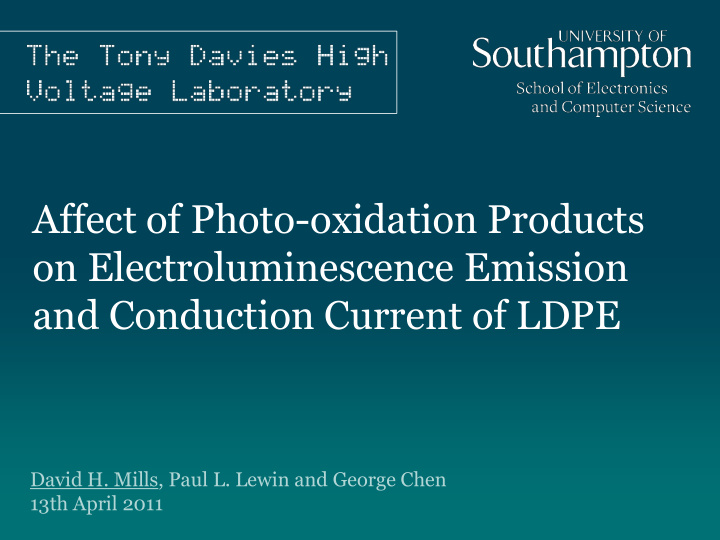



Affect of Photo-oxidation Products on Electroluminescence Emission and Conduction Current of LDPE David H. Mills, Paul L. Lewin and George Chen 13th April 2011
Introduction • Ageing of high voltage insulation – Interest in mechanisms behind ageing process – Improving dielectric design and life time estimation – Role of charge trapping and movement in material ageing. • Artificial ageing – Generation of oxidation products and cross-linking – Affect on charge injection, trapping and recombination 2
Experiment • Chosen a standard polymeric system – 100 µm low density polyethylene (LDPE) films – Ultraviolet ageing with peak emission of 253.7nm • UV affect – Electrical changes and chemical structure – Charge movement in the bulk and near the electrode- polymer interface.
What is Electroluminescence? • Low level light emission from electrically stressed polymers • Bipolar recombination of charge carriers – AC stress, emission is thought to originate near the electrode- polymer interface. – Emission peaks in first and third quadrants 4
Ageing Process • Experiment setup – 36 W UV fluorescent tube with peak emission at 253.7 nm – Samples mounted away from reflective back wall – Fan oven at constant 40 o C – 100 µm LDPE film – Aged in 3 and 7 day intervals up to 17 days. 5
Ageing Effects
Dielectric Strength • ASTM D149 standard (50 Hz, 50 V/s ramp, 6.3 mm steel ball bearings) • Reduced breakdown strength with ageing • Reduced uniformity α Value β Sample Age (kV/mm) Value 2 Parameter Weibull Distribution 160.1 ± 1.2 Virgin 43.0 154.4 ± 2.5 x x 7 Days 19.9 t P x 1 exp f 17 Days 151.1 ± 2.7 7 17.7
FTIR spectra – Oxidation Products • Increased Carbonyl and Hydroxyl groups • No effect due to 40 o C temperature • Chemical (deep) trapping sites 8
Dissolving in Xylene – Cross-linked • Samples dissolved in boiling Xylene for 1 hour and then dried. • Initially large increase in cross- linking • Cross-linking reduces as ageing time continues 9
Charge Transport
Pulsed Electro-Acoustic (PEA) Experiment • 40 minutes charging, 20 minutes decay • 40 kV/mm dc field, calibrated at 10 kV/mm • Top electrode – semiconducting polymer • Bottom electrode - aluminium 11
PEA Results 12
Total Bulk Charge 13
Electroluminescence
Electroluminescence Experiment • Experiment under dry nitrogen at 1 bar above atmospheric. • 50 Hz, sinusoidal field. • Gold sputter coat ~20 nm each side. • Total EL emission during 1 ac cycle, averaged over 100 cycles. 15
Electroluminescence Results • Increased EL and cross-linking initially. • Increased cross- linking maintained, reduced EL with further ageing. 16
Electroluminescence Results • Carbonyl absorbance taken at 1714 cm -1 • Oxidation products are seen to increase with ageing time. 17
Electroluminescence Results • Measured bulk charge after 40 minutes. • Initially bulk charge reduces up to 7 days • Further ageing increases bulk charge 18
Conclusions • This initial work aims to improve understanding in the role of charge movement in the ageing of high voltage insulation • LDPE was UV aged, resulting in: – A reduction in dielectric strength – Increased cross-linking – Increased oxidation products 19
Conclusions Continued • Experiments to investigate charge movement showed: – Initially less charge is trapped within the bulk but this increases with further ageing. – Initially stronger electroluminescence but this reduces with further ageing. • A build up of charge traps near the electrode-polymer interface limits charge injection into the bulk. Continued ageing shows greater oxidation allowing for charge injection and trapping within the bulk of the polymer. 20
Recommend
More recommend